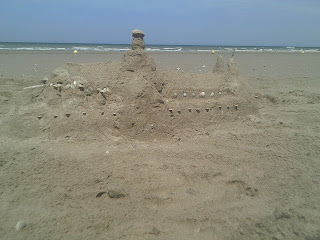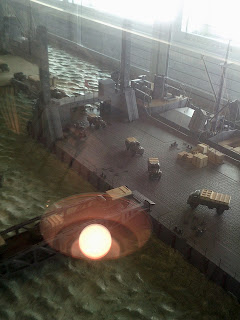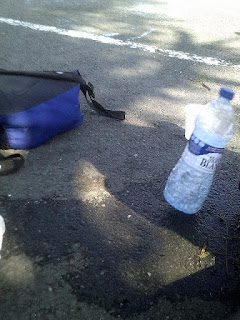Monday, 31 July 2017
Norwegian Jade on the horizon
We spotted the Norwegian Jade cruise ship from the beach at Rosemarkie. If my little finger subtends 1 degree then the ship subtends 1/6 of a degree or 0.0029 radians. If the ship is 50 metres high, it means by the arc length rule that it is about 50/0.0029 = 17188 metres away. 17 km is about 10 miles.
Sunday, 30 July 2017
Feedback about my band
I'm in a band. We played a well received gig recently. Parking the guitar in front of the amp is a god way of attracting feedback. What's happening? Well, I knew that the amplifier sound waves coming out of the amplifier make the vibrations bigger, but which vibrations? I had thought it would be by making the strings vibrate more - a resonance effect. According to the Fender website, it is that the sound waves make the pick up coils vibrate and this is called having the pick ups go "microphonic". https://www.fender.com/articles/tech-talk/friend-or-foe-a-feedback-primer The frequency at which pick up coils vibrate is very high because of the thin wire from which they are made, hence the very high frequency squeal.
Saturday, 29 July 2017
96 dB: the sound of the summer
My lawn mower claims to be 96dB. I used a digital meter to test that claim. Sat right on top of the grass box, it was claiming >100dB. But intensity diminishes with distance and it turns out that the claim is correct where my head is. I have read that 120dB is the threshold of pain. This is nowhere near. A source suggested you might be all right for 4 hours at this volume. It wouldn't be a pleasant 4 hours though because it's not a nice noise.
Friday, 28 July 2017
Hugh Miller of Cromaty & American Gods
We visited the house of Hugh Miller, the Scottish 19th Century geologist and social activist. The lovely modern garden had the above quotation from him carved in stone. I've been reading Neil Gaiman's novel American Gods. On page 152, the lead character says: " All we have to believe with is our senses:the tools we use to perceive the world, our sight, our touch, our memory. If they lie to us, then nothing can be trusted." Hugh Miller is now lauded as an acute observer rather more than as a theorist. Senses were everything.
Thursday, 27 July 2017
More polarised light at Loch Brandy
Here are two photographs taken with a polarising filter at 90 degrees turn between shots. Notice that a small cloud bottom centre looks black in the top photograph and bright gleaming white in the bottom photograph. My shoulder was to the sun so the sky should be polarised. I think the blue is polarised but the white scattered light isn't. Top photo features more white.
Wednesday, 26 July 2017
A trace of lenticular cloud in Glen Clova
This picture will need expanding to see the detail. It had all but disappeared by the time I was able to stop safely for the photograph. The main bit of the lenticular is middle left but to the right of this there is the trace of the top of a wave shape - just the upper whisp of the lens shape. Maybe here we have to "loops" of a stationary wave, as I call them in class. Putting the two together gives a full wavelength. Sadly, there is nothing to measure the scale against. There is no knowing how far away the clouds are.
Monday, 24 July 2017
French power lines
I'm always a sucker for foreign power lines. These ones in Normandy look like the pylons have horns. That's because there are two earth wires running along the top. These earth wires protect against lightning strikes. I wonder whether these offer more protection than our single lines.
Saturday, 22 July 2017
Polarised views of Loch Brandy
The top photograph shows what you see with the naked eye. The bottom photograph shows what is seen through the polarising filter that is my sun glasses. Reflected light is plane polarised if the angle of incidence is above the Brewster angle. If the filter is aligned at 90 degrees to the polarisation plane, the annoying reflected light from the surface of the water is removed and you can clearly see the submerged causeway that is shown on the map. Speculation is that it may have been a glacial deposit then adapted for fishing purposes. https://www.walkhighlands.co.uk/Forum/viewtopic.php?f=1&t=12876
Friday, 21 July 2017
Surface tension and a Bayeux Cathedral sandcastle
We built a sandcastle of Bayeux Cathedral but as the sand dried, it started to collapse. So why is wet sand a better building material? The answer appears to be surface tension of water. Water molecules pull on each other using small static electric charges. In the middle of a body of water, a molecule is pulled in all directions. On the edge, there is nothing pulling it in the direction of the air so it is pulled more strongly into the water. This results in a tight outer edge making water droplets. This inward pull of water means it can pull sand grains on either side of it inwards. This seems like a good explanation: http://myqacorner.blogspot.co.uk/2012/03/why-does-damp-sand-hold-shape-of-castle.html
Thursday, 20 July 2017
Flow rate problems on the Kentmere Fell Race
The race got off to a steady start with all competitors moving off at a reasonable pace. However the back of the race that we could see came to a standstill very quickly. Maybe the road narrowed or maybe the first competitors hitting the slope to the church made them slow down. I think that the race must act as an incompressible fluid - or at least when the competitors are close together at the start. The race got me to look up Bernoulli's principle that I understood 30 years ago. Some work to be done to get the understanding back https://en.wikipedia.org/wiki/Bernoulli%27s_principle
Wednesday, 19 July 2017
Galilean Thermometer: a hot day in Cumbria
This doesn't usually happen. In hot weather, the clear liquid in the thermometer expands and becomes less dense. The balls in the middle float when they are less dense than the clear liquid. The balls have different densities that are linked to the density of the clear liquid at a given temperature. The lowest ball is the most dense of the 4 balls and sinks when the temperature reaches 20 degrees Celsius.
Sunday, 16 July 2017
Running speed for the Kentmere Fell Race
We went to watch the Kentmere Fell Race. It is 19.8 km long and our competitor took 2 hours and 5 mins. That's an average speed of 19800 metres divided by 7500 seconds = 2.6 metres per second. The new GCSE syllabus says that you run at about 3 metres per second. I think given the terrain that we have seen a very impressive performance!
Wednesday, 12 July 2017
Daytime cumulus over land at Silloth
It was a beautiful day at Silloth today. The land has a lower specific heat capacity than the sea so the sunlight raises the temperature of the land more quickly. The air over land is hotter so becomes less dense and rises. The air cools over the sea and falls. The cycle is completed by a lower level sea breeze. This brings in moist air off the sea. This then rises due to the convection previously described. As air rises, it cools. Eventually, the dew point is reached and the water vapour condenses to form cumulus clouds. So during the day the cumulus clouds are above the land. That was obvious today. My source article suggests that the opposite happens at night. I need to observe this. http://www.metoffice.gov.uk/learning/clouds/low-level-clouds/cumulus
Tuesday, 11 July 2017
Mulberry Harbour and Tidal Range at Arromanches
Big ships are so deep that they can't get close to a beach without getting their bottoms stuck in the sand. This caused a problem after D-Day. The solution was to build a deep water harbour. Another problem is that the depth of the water changes twice a day due to the tides. The tidal range in the English Channel is particularly high. I have posted about the tides on Guernsey before. The reason seems to be to do with the geometry of the channel. There are some places on Earth where the tidal range is almost zero. I need to find out where and go! If you build a fixed pier then ships that dock against it will be at the right level at some times of the day and far too low down at other times. So at Arromanches, the revolutionary design was to put some big poles (called piles) into the seabed and to clip the pier around them. The pier wasn't completely fixed - it was free to go up and down with the tides.
These days the design is used for yacht piers. This one is at Baie d'Orne, looking towards Ouistreham ferry terminal. Looking at the height of the poles, the tidal range must be up to 4 metres.
Monday, 10 July 2017
Simultaneity and the Bayeux Tapestry
I wasn't allowed to photograph the tapestry itself so to show you that this is about time, I photographed my watch outside. Here's the bit I liked the most http://www.bayeuxtapestry.org.uk/bayeux13.htm It says that Edward the Confessor "defunctus est". Well, he died - but I like the idea of him being defunct. However, the order of the pictures is reversed. On the left he is being carried to his funeral to be buried. Then in the next picture he dies. Then Harold becomes king. In Einstein's Physics, the order of events depends on the viewpoint of the observer. In Einstein' Physics, it depends on the speed of movement of the observer. But History also depends on the viewpoint of the writer of history. I was told that here the key thing required was the emphasis on the death of Edward.
Sunday, 9 July 2017
Landing the bottle whilst we waited
We tried to land the bottle upright whilst we waited for the coach to be fixed.
I'm no expert but my students pointed out from their experience that it depends on how full the bottle is.
There are two bits of Physics going on. Whilst the bottle is spinning, the bottom of the bottle exerts a centripetal force onto the water to keep it moving in a circle and to stop it heading off in a straight line. The more the mass of water, the more the inertia so the bigger force needed to get it into a circle. The spinning bottle will then have more angular momentum. Momentum is a measure of how hard it is to stop something moving so with more water, the floor will have to exert a bigger force to stop the bottle.
The second bit of Physics is about stability. The bottle almost always lands on its edge at an angle. As long as the arrow showing its weight acting down through the centre of mass passes through the bottom of the bottle, the bottle will go back upright. The more water, the higher the centre of mass and the more likely the arrow is to pass outside the bottom of the bottle and tip the bottle.
I'm no expert but my students pointed out from their experience that it depends on how full the bottle is.
There are two bits of Physics going on. Whilst the bottle is spinning, the bottom of the bottle exerts a centripetal force onto the water to keep it moving in a circle and to stop it heading off in a straight line. The more the mass of water, the more the inertia so the bigger force needed to get it into a circle. The spinning bottle will then have more angular momentum. Momentum is a measure of how hard it is to stop something moving so with more water, the floor will have to exert a bigger force to stop the bottle.
The second bit of Physics is about stability. The bottle almost always lands on its edge at an angle. As long as the arrow showing its weight acting down through the centre of mass passes through the bottom of the bottle, the bottle will go back upright. The more water, the higher the centre of mass and the more likely the arrow is to pass outside the bottom of the bottle and tip the bottle.
Saturday, 8 July 2017
Impromptu kazoo at the chocolate factory
We made kazoos from blades of grass to entertain ourselves when the coach needed fixing outside the chocolate factory in Deauville. You pick a wide blade of grass and wedge it between your thumbs, securing it at both ends. You blow over the grass blade. The air flow is split by the grass blade. As it passes the far edge of the grass, tiny whirlpools of air called vortices form. This is called vortex shedding. They push the grass blade first one way and then the other way making it vibrate. If the frequency of vibration matches that preferred by the length of grass, then resonance occurs and the vibration is enough to be heard.
Subscribe to:
Comments (Atom)






























